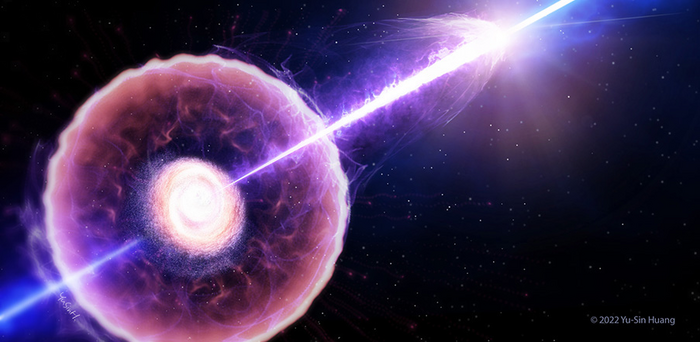Gamma-ray bursts are the most luminous explosions in the universe, allowing astrologists to observe intense gamma rays in short durations. Gamma-ray bursts are classified as either short or long, with long gamma-ray bursts being the result of massive stars dying out. Hence why they provide hidden clues about the evolution of the universe.

Credit: Urata et al./Yu-Sin Huang/MITOS Science CO., LTD.
Gamma-ray bursts are the most luminous explosions in the universe, allowing astrologists to observe intense gamma rays in short durations. Gamma-ray bursts are classified as either short or long, with long gamma-ray bursts being the result of massive stars dying out. Hence why they provide hidden clues about the evolution of the universe.
Gamma-ray bursts emit gamma rays as well as radio waves, optical lights, and X-rays. When the conversion of explosion energy to emitted energy, i.e., the conversion efficiency, is high, the total explosion energy can be calculated by simply adding all the emitted energy. But when the conversion efficiency is low or unknown, measuring the emitted energy alone is not enough.
Now, a team of astrophysicists has succeeded in measuring a gamma-ray burst’s hidden energy by utilizing light polarization. The team was led by Dr. Yuji Urata from the National Central University in Taiwan and MITOS Science CO., LTD and Professor Kenji Toma from Tohoku University’s Frontier Research Institute for Interdisciplinary Sciences (FRIS).
Details of their findings were published in the journal Nature Astronomy on December 8, 2022.
When an electromagnetic wave is polarized, it means that the oscillation of that wave flows in one direction. While light emitted from stars is not polarized, the reflection of that light is. Many everyday items such as sunglasses and light shields utilize polarization to block out the glare of lights traveling in a uniform direction.
Measuring the degree of polarization is referred to as polarimetry. In astrophysical observations, measuring a celestial object’s polarimetry is not as easy as measuring its brightness. But it offers valuable information on the physical conditions of objects.
The team looked at a gamma-ray burst which occurred on December 21, 2019 (GRB191221B). Using the Very Large Telescope of the European Southern Observatory and Atacama Large Millimeter/submillimeter Array – some of the world’s most advanced optical and radio telescopes – they calculated the polarimetry of fast-fading emissions from GRB191221B. They then successfully measured the optical and radio polarizations simultaneously, finding the radio polarization degree to be significantly lower than the optical one.
“This difference in polarization at the two wavelengths reveals detailed physical conditions of the gamma-ray burst’s emission region,” said Toma. “In particular, it allowed us to measure the previously unmeasurable hidden energy.”
When accounting for the hidden energy, the team revealed that the total energy was about 3.5 times bigger than previous estimates.
With the explosion energy representing the gravitational energy of the progenitor star, being able to measure this figure has important ramifications for determining stars’ masses.
“Knowing the measurements of the progenitor star’s true masses will help in understanding the evolutionary history of the universe,” added Toma. “The first stars in the universe could be discovered if we can detect their long gamma-ray bursts.”
Journal
Nature Astronomy
DOI
10.1038/s41550-022-01832-7
Article Title
Simultaneous radio and optical polarimetry of GRB 191221B afterglow
Article Publication Date
8-Dec-2022




